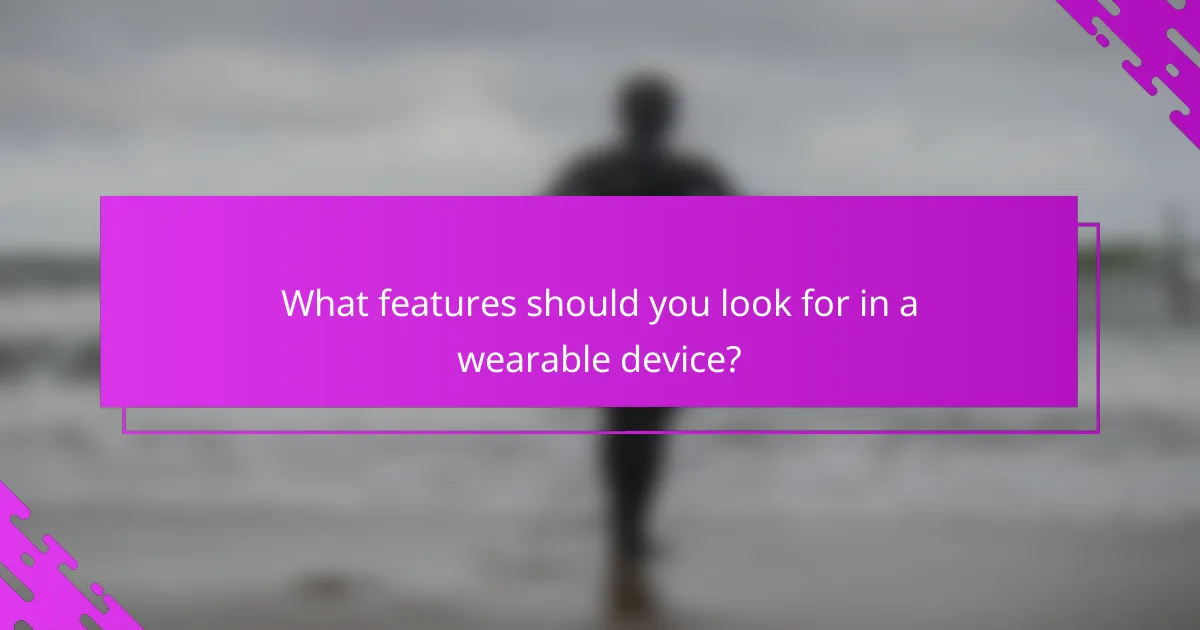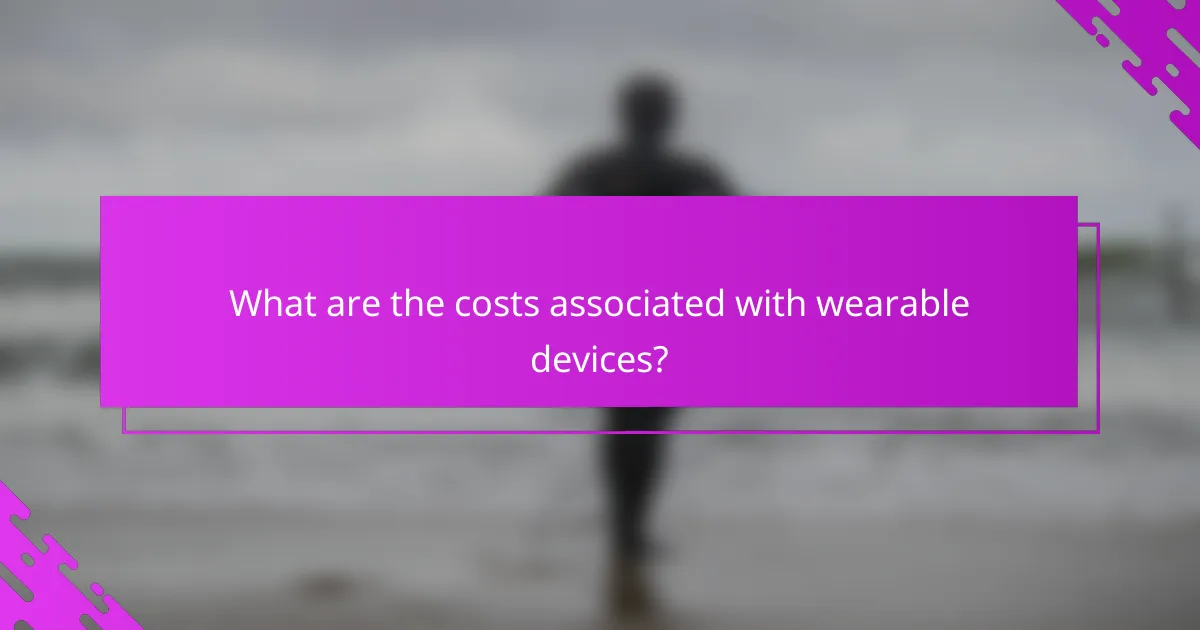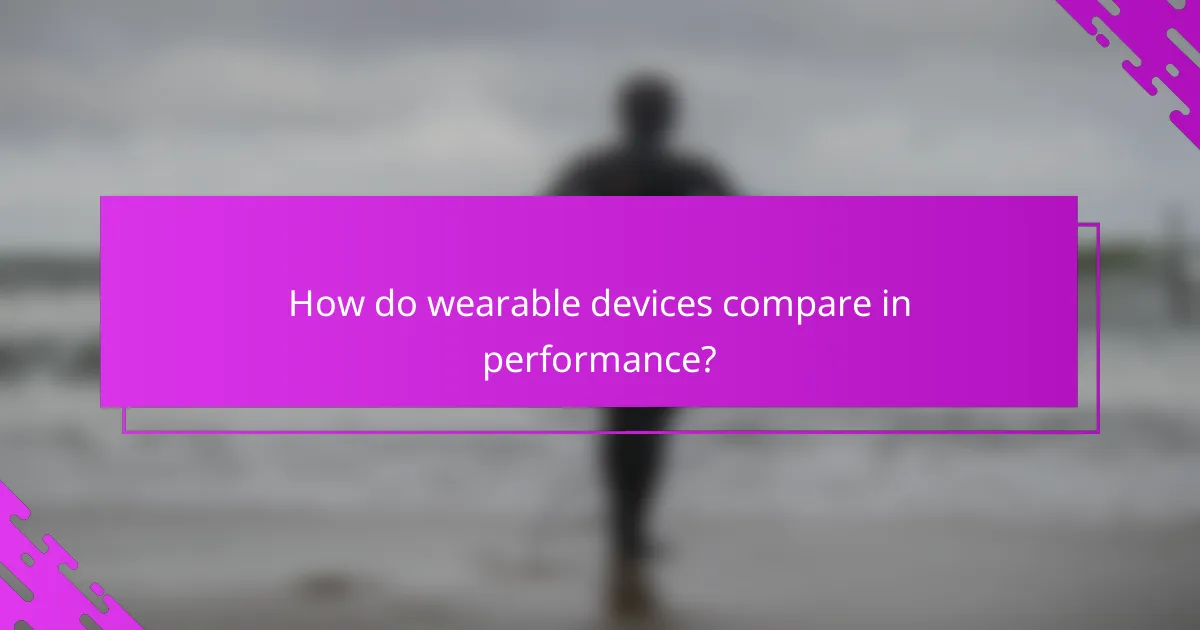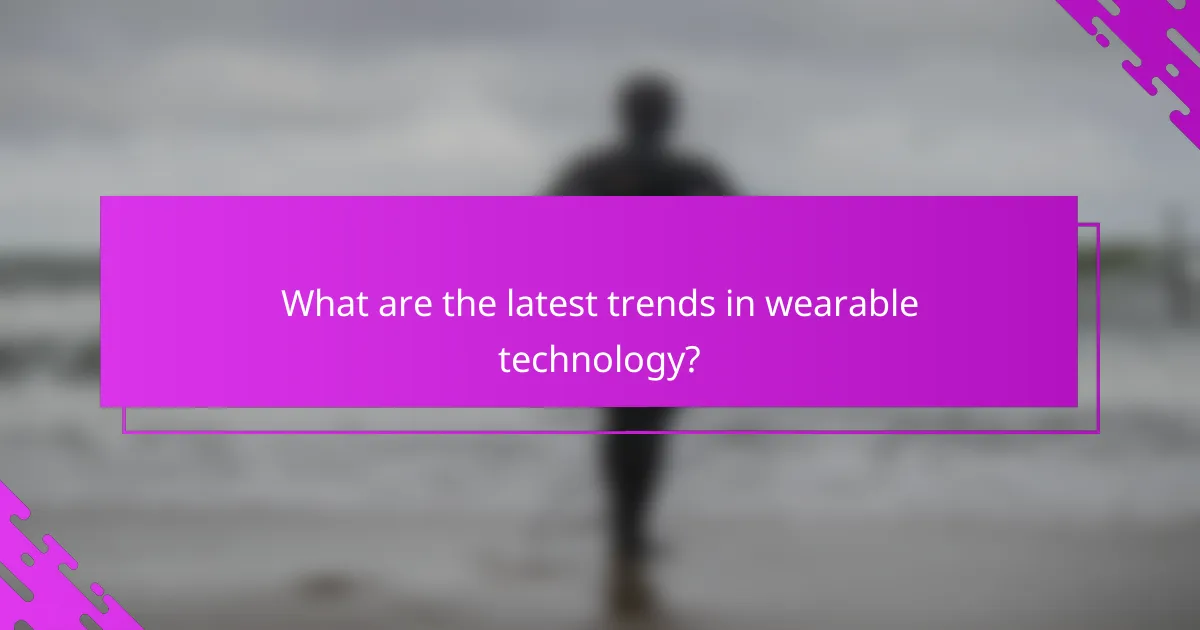Wearable devices can significantly aid in reaching health goals by providing real-time data and insights into various aspects of health and fitness. Choosing the right device involves understanding your specific objectives and prioritizing features like heart rate monitoring, GPS tracking, and sleep tracking to effectively support your health journey.

What wearable devices help achieve health goals?
Wearable devices can significantly aid in reaching health goals by providing real-time data and insights into various aspects of health and fitness. Depending on your specific objectives, different devices offer unique features tailored to track fitness, monitor heart health, or improve sleep quality.
Fitbit Charge 5 for fitness tracking
The Fitbit Charge 5 is designed for those focused on fitness tracking, offering features like heart rate monitoring, GPS, and activity tracking. It provides insights into daily steps, calories burned, and active minutes, helping users set and achieve fitness goals.
Consider its built-in stress management tools and sleep tracking capabilities, which can enhance overall wellness. The device is user-friendly, making it suitable for beginners and seasoned fitness enthusiasts alike.
Apple Watch Series 8 for heart health
The Apple Watch Series 8 excels in monitoring heart health with its ECG app and heart rate notifications. It can alert users to irregular heart rhythms, providing peace of mind for those concerned about cardiovascular issues.
Additionally, it integrates seamlessly with the iOS ecosystem, allowing users to track workouts, manage notifications, and even access health records. This device is ideal for individuals who prioritize heart health and enjoy a comprehensive smartwatch experience.
Garmin Venu 2 for outdoor activities
The Garmin Venu 2 is perfect for outdoor enthusiasts, featuring built-in GPS and a variety of sports modes. It tracks activities like running, cycling, and hiking, providing detailed metrics such as pace, distance, and elevation.
This device also includes health monitoring features like stress tracking and sleep analysis, making it a well-rounded choice for those who enjoy an active lifestyle. Its robust battery life ensures it can keep up with extended outdoor adventures.
Oura Ring for sleep monitoring
The Oura Ring specializes in sleep monitoring, offering insights into sleep quality, duration, and readiness for the day. Its sleek design makes it easy to wear overnight without discomfort.
Users receive personalized recommendations based on their sleep patterns, helping them improve their rest and recovery. This device is ideal for individuals who prioritize sleep health and want a discreet tracking option.
Samsung Galaxy Watch 5 for comprehensive health metrics
The Samsung Galaxy Watch 5 provides a wide range of health metrics, including body composition analysis, heart rate monitoring, and sleep tracking. Its comprehensive health features make it suitable for users looking to monitor multiple aspects of their wellness.
This smartwatch also supports various fitness tracking modes and integrates with Samsung Health, allowing for a holistic view of health data. It’s a great choice for those who want a versatile device that balances fitness and everyday functionality.

How to choose the right wearable device?
Choosing the right wearable device involves understanding your health goals, ensuring compatibility with your smartphone, and assessing battery life and durability. By focusing on these key factors, you can select a device that effectively supports your health journey.
Identify personal health goals
Start by determining what you want to achieve with a wearable device. Common goals include tracking physical activity, monitoring heart rate, managing stress, or improving sleep quality. Clearly defined objectives will help narrow down your options.
For instance, if weight loss is your goal, look for devices that offer comprehensive activity tracking and calorie counting features. Alternatively, if you aim to enhance your sleep, prioritize wearables with advanced sleep monitoring capabilities.
Consider device compatibility with smartphones
Ensure the wearable device you choose is compatible with your smartphone’s operating system. Most wearables work with either iOS or Android, but some may have limited functionality based on the platform.
Check the manufacturer’s specifications for compatibility details. Additionally, consider the companion app’s features, as a well-designed app can enhance your experience by providing insights and data analysis.
Evaluate battery life and durability
Battery life is a crucial factor when selecting a wearable device. Look for devices that offer at least several days of battery life, especially if you plan to wear it continuously. Some advanced models may even last up to two weeks on a single charge.
Durability is equally important, particularly for fitness enthusiasts. Choose wearables that are water-resistant and built to withstand daily wear and tear. Check for ratings like IP67 or IP68, which indicate resistance to dust and water immersion.

What features should you look for in a wearable device?
When selecting a wearable device, prioritize features that align with your health goals, such as heart rate monitoring, GPS tracking, sleep tracking, and water resistance. Each feature plays a crucial role in enhancing your fitness experience and ensuring accurate data collection.
Heart rate monitoring capabilities
Heart rate monitoring is essential for tracking your cardiovascular health and optimizing workouts. Look for devices that offer continuous heart rate tracking, which provides real-time data during various activities. Many wearables now include features like heart rate zones, allowing you to tailor your training intensity.
Consider devices that utilize optical sensors for accuracy, as they typically provide reliable readings. Some models also offer alerts for abnormal heart rates, which can be beneficial for those with specific health concerns.
GPS tracking for outdoor sports
GPS tracking is vital for outdoor enthusiasts who engage in activities like running, cycling, or hiking. A wearable with built-in GPS allows you to map your routes, track distance, and monitor pace without needing a smartphone. This feature is particularly useful for athletes looking to analyze performance metrics.
When choosing a device, check for GPS accuracy and battery life, as some wearables may drain quickly when using GPS. Look for models that offer offline maps or route planning for added convenience during long outings.
Sleep tracking accuracy
Accurate sleep tracking can help you understand your sleep patterns and improve your overall health. Look for wearables that provide detailed insights into sleep stages, such as light, deep, and REM sleep. This information can help you identify factors affecting your sleep quality.
Some devices use advanced sensors to monitor movement and heart rate during sleep, providing more precise data. Consider wearables that offer sleep coaching or personalized recommendations based on your sleep data to enhance your rest.
Water resistance ratings
Water resistance is a crucial feature for wearables, especially for swimmers or those who engage in outdoor activities. Look for devices with an IP68 rating or higher, which indicates they can withstand submersion in water. This ensures durability and functionality during water-related activities.
Keep in mind that water resistance ratings can vary; some devices may be suitable for swimming, while others are only splash-proof. Always check the manufacturer’s specifications to ensure the wearable meets your specific needs for water exposure.

What are the costs associated with wearable devices?
The costs associated with wearable devices can vary significantly based on the model, features, and subscription services. Initial purchase prices can range from budget-friendly options to high-end models, while ongoing costs may include subscriptions for premium features or services.
Price range of popular models
Popular wearable devices typically range in price from around $50 to over $500. Budget models often provide essential tracking features, while mid-range options may include advanced health metrics and smartphone integration. High-end devices often offer comprehensive health monitoring, GPS capabilities, and premium materials.
For example, fitness trackers like the Xiaomi Mi Band can be found for approximately $30, while smartwatches like the Apple Watch may start at around $400, depending on the features and materials selected.
Subscription costs for premium features
Many wearable devices offer subscription services that enhance functionality, such as personalized coaching, advanced health analytics, or access to exclusive content. These subscriptions typically range from $5 to $15 per month.
For instance, platforms like Fitbit Premium charge around $10 monthly, providing users with detailed insights and tailored workout plans. It’s important to evaluate whether these additional features align with your health goals before committing to a subscription.
Long-term value of investment
Investing in a wearable device can yield significant long-term benefits, particularly for those focused on health and fitness. By tracking metrics like heart rate, sleep patterns, and activity levels, users can make informed decisions that may lead to improved health outcomes.
Consider the potential savings on healthcare costs through proactive health management. While the initial investment may seem high, the long-term value can outweigh the costs if it leads to better health and lifestyle choices.

How do wearable devices compare in performance?
Wearable devices vary significantly in performance based on their features, accuracy, and intended use. Key factors to consider include heart rate monitoring, GPS accuracy, battery life, and compatibility with health apps.
Fitbit vs. Apple Watch performance metrics
Fitbit devices typically excel in basic health tracking, offering reliable heart rate monitoring and sleep analysis. They are often favored for their long battery life, which can last several days, making them ideal for continuous tracking.
On the other hand, the Apple Watch provides advanced performance metrics, including ECG monitoring and blood oxygen levels. While its battery life is shorter, lasting about a day, it compensates with a robust ecosystem of apps and seamless integration with iOS devices.
Garmin vs. Samsung for fitness enthusiasts
Garmin is known for its precision in fitness tracking, particularly for outdoor activities like running and cycling. Many Garmin models feature advanced GPS capabilities and longer battery life, making them suitable for serious athletes.
Samsung devices, such as the Galaxy Watch, offer a balanced approach with fitness tracking and smart features. They provide good heart rate monitoring and activity tracking, but may not match Garmin’s depth in specialized fitness metrics. Samsung watches typically have a battery life of around two days, which is decent for daily wear.

What are the latest trends in wearable technology?
The latest trends in wearable technology focus on enhanced health monitoring, seamless integration with telehealth services, and improved user experience. Devices are becoming more sophisticated, offering features like continuous health tracking, personalized insights, and connectivity with healthcare providers.
Integration with telehealth services
Wearable devices are increasingly integrating with telehealth services, allowing users to share health data directly with healthcare professionals. This integration facilitates real-time monitoring and enables timely interventions, which can be crucial for managing chronic conditions.
For example, a smartwatch that tracks heart rate and sends alerts can notify a doctor if irregularities are detected. This immediate data sharing can enhance patient care and reduce the need for in-person visits, making healthcare more accessible and efficient.
When choosing a wearable, consider its compatibility with telehealth platforms. Look for devices that support popular telehealth apps or have built-in features that allow for easy data sharing. Ensure the device complies with local regulations, such as HIPAA in the U.S., to protect your health information.
